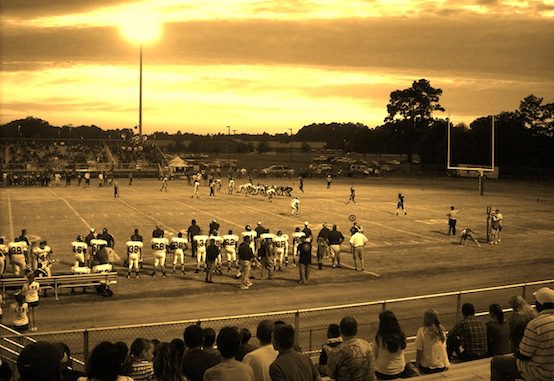The Tocquevillian Case for High School Football

Emma Green over at The Atlantic offered up a classic case of TAC-bait on Monday, in response to Amanda Ripley’s October attack on high school sports.
Ripley had argued, with nuance and evidence and thorough argument to be sure, that the overriding emphasis that many American school systems place on high school athletics detracts from the educational mission of our educative institutions. She brought particular attention to the tremendous cost of maintaining teams, especially once travel, and cheerleaders, and substitute teachers come into play. Her primary case study, the Premont Independent School District, axed its sports programs in the midst of extreme financial stress, realizing that “football at Premont cost about $1,300 a player. Math, by contrast, cost just $618 a student.”
Green brought to print a debate Ripley had under the auspices of the New America Foundation on this very topic. At the debate, Grantland contributor and New America fellow Louisa Thomas brought Tocqueville onto the field:
We’re a nation of joiners—this is like Tocqueville’s original insight,” Thomas said. “This is a country in which people are drawn to teams; communities build themselves. In other countries, there’s a great sense of inherited identity. One of the functions that sports plays is social cohesion, and it’s a mistake to understate how important that can be.
Green continued to note that “For some students and their families, other after-school activities might satisfy this urge to form and join groups. But for many, Friday-night football and Saturday games of soccer are part of a broader spirit of sharing a common goal and being part of a community.” She quotes Tocqueville himself in his famous description: “Americans of all ages, all conditions, and all dispositions constantly form associations. They have not only commercial and manufacturing companies, in which all take part, but associations of a thousand other kinds, religious, moral, serious, futile, general or restricted, enormous or diminutive.”
It should be noted that voluntary associations apart from school play a large part in youth athletics already. Pop Warner football and Little League baseball are the quintessential examples of community-supported competition, where the local hardware store sponsors a team that squares off against the grocer’s boys. At higher levels of non-football sports, the outside organizations have even started to eclipse high schools, as AAU basketball circuits have surpassed the high school in collegiate talent evaluation, and travel soccer and softball teams fill their weekends with tournaments.
For football though, high school is still king. It is the most expensive sport to run, with the largest rosters, and often has, for the sake of pure preservation, the fewest games. They bring the cheerleading squads to the field, and the geeks get in on the action with their precisely choreographed marching band routines. They bring a town together, as students from one side of the county meet and mix with other schools, often drawn from very different populations.
Taking the whole ensemble on the road is expensive to be sure, and firing up the Friday Night Lights over a state-of-the-art field smacks of classic American commercial excess. The concussion crisis can’t be discounted, nor the risks of educational distraction. But there’s more to school than test scores. There’s an education in self-governance, and an orientation towards community during the time when we can feel most alienated.